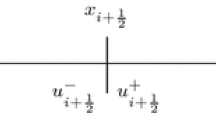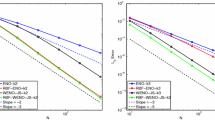Abstract
We comment on the use of radial basis functions in the dual reciprocity method (DRM), particularly thin plate splines as used in Agnantiaris et al. (1996). We note that the omission of the linear terms could have biased the numerical results as has occurred in several previous studies. Furthermore, we show that a full understanding of the convergence behavior of the DRM requires one to consider both interpolation and BEM errors, since the latter can offset the effect of improved data approximation. For a model Poisson problem this is demonstrated theoretically and the results confirmed by a numerical experiment.
Similar content being viewed by others
Author information
Authors and Affiliations
Rights and permissions
About this article
Cite this article
Golberg, M., Chen, C., Bowman, H. et al. Some comments on the use of Radial Basis Functions in the Dual Reciprocity Method. Computational Mechanics 21, 141–148 (1998). https://doi.org/10.1007/s004660050290
Issue Date:
DOI: https://doi.org/10.1007/s004660050290




